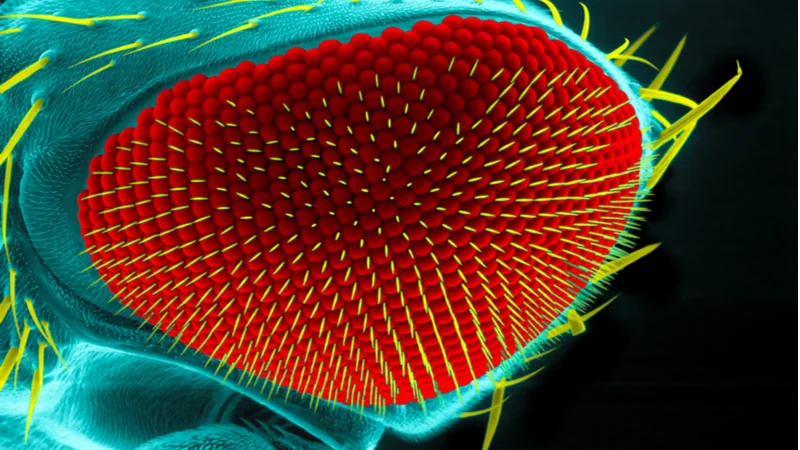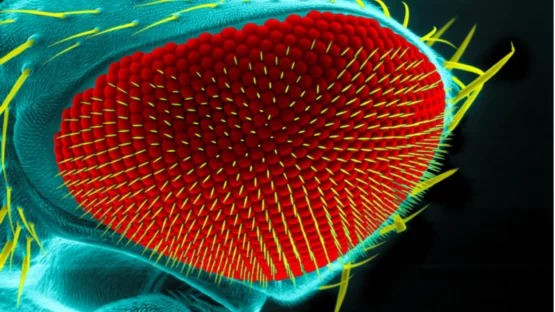A new study published in Nature has reported on how caloric restriction, circadian rhythms, and molecular clocks interact to affect the ocular health and lifespan of fruit flies.
Circadian rhythms, clock genes, and photoreceptors
The researchers begin their paper by discussing the concept of circadian rhythms, which are the 24-hour cycles that organisms have evolved to live on Earth [1]. In Drosophila fruit flies, this is largely controlled by feedback loops: two transcription factors, Clock (CLK) and Cycle (CYC), cause the activation of their own repressors, Period (PER) and Timeless (TIM) [2]. This is true both for central clocks and for peripheral tissue clocks, such as the ones in the eye that are the focus of this study [3].
Previous research has shown that dietary restriction, a well-known method of extending lifespan, has effects on the circadian rhythms of fruit flies, promoting their proper function during aging [4]. Similarly, mice on a high-fat diet have their circadian rhythms disrupted in a way that promotes aging [5]. That research, however, was not focused specifically on the eye.
Targeted effectiveness
In this paper, the researchers defined an ordinary, freely fed (ad libitum) diet as consisting of 5% yeast, while flies under dietary restriction consumed a tenth as much yeast.
This research is specifically on endogenous clocks, rather than light-driven biofeedback. To narrow down which genes and pathways were involved, the researchers employed mutant flies that lacked any endogenous clocks and whose rhythms only directly responded to light.
The effects of dietary restriction on wild-type flies were substantial. Oscillating genes related to eye function were substantially upregulated in the restricted group of wild-type flies, and their rhymic oscillation was substantially enhanced: a barely visible signal in the ad libitum group was strongly visible in the restricted group.
However, while some genes were upregulated in clockless flies, dietary restriction failed to lead to any such rhythmic effect in them. In that respect, this intervention must have only had its effects on the endogenous clock.
The researchers also created flies that had the core clock factor CLK downregulated, identifying which particular genes affected by dietary restriction were related to this specific gene. As expected, these flies had significant inflammation and did not live nearly as long as their unmodified counterparts, even when the knockdown was only in the eye. Similarly, knocking down the particular genes affected by CLK caused significant decline, both in photoreceptor viability and in lifespan.
A direct relationship between photoreceptors, CLK, and eye health
The researchers created a fly model with CLK upregulated and compared them to CLK-downregulated and wild-type flies in both ad libitum and dietary restriction conditions. The findings were as expected. Flies age quickly, but the CLK-downregulated flies had their visual systems rapidly destroyed, especially the ones fed an ad libitum diet. The CLK-upregulated flies fared even better than the wild-type flies in this respect.
Dietary restriction substantially improved outcomes in all three groups. After two weeks of dietary restriction, the CLK-downregulated flies were doing almost as well as the ad libitum group, and the wild-type flies were doing almost as well as the CLK-upregulated group.
The researchers also performed experiments relating to photoreceptor activation and immune health. The ion regulator ATPα is affected by circadian regulation [6], and its knockdown drives age-dependent degeneration [7]. These researchers found that dietary restriction had no effect on this fact.
However, dietary restriction did have an effect on normal, light-induced eye stress. Flies on an ad libitum diet lived longer in complete darkness, but flies under dietary restriction did not live any longer than such flies normally do. Therefore, as the researchers reason, dietary restriction must be protecting the flies from the negative effects of such stress. Further experiments with mutants confirmed this finding.
Conclusion
As this is a fly study, it has yet to be proven that these findings are applicable to people at all. However, the researchers point out previous research showing that fruit flies and mammals show commonalities in how their eyes internally regulate their circadian clocks [8]. Therefore, it is reasonable to believe that a mouse study, and possibly human clinical trials, can result from this exploratory research.
The researchers arrive at an interesting hypothesis in their conclusion. They believe that vision, itself, may cause significant inflammatory harm to an organism as it ages. This is an example of antagonistic pleiotropy, a way in which functional improvements lead to shorter lifespans. They note prior research showing that many long-lived organisms with regressed visual systems, such as naked mole rats and cave fish, often live much longer than their surface-dwelling counterparts [9].
If their hypothesis is correct and the degradation of vision is directly related to shorter lifespans, it makes interventions to slow or prevent such decline that much more important.
Literature
[1] Rijo-Ferreira, F., & Takahashi, J. S. (2019). Genomics of circadian rhythms in health and disease. Genome medicine, 11(1), 1-16.
[2] Patke, A., Young, M. W., & Axelrod, S. (2020). Molecular mechanisms and physiological importance of circadian rhythms. Nature reviews Molecular cell biology, 21(2), 67-84.
[3] Ogueta, M., Hardie, R. C., & Stanewsky, R. (2018). Non-canonical phototransduction mediates synchronization of the Drosophila melanogaster circadian clock and retinal light responses. Current Biology, 28(11), 1725-1735.
[4] Katewa, S. D., Akagi, K., Bose, N., Rakshit, K., Camarella, T., Zheng, X., … & Kapahi, P. (2016). Peripheral circadian clocks mediate dietary restriction-dependent changes in lifespan and fat metabolism in Drosophila. Cell metabolism, 23(1), 143-154.
[5] Honma, T., Shinohara, N., Ito, J., Kijima, R., Sugawara, S., Arai, T., … & Ikeda, I. (2012). High-fat diet intake accelerates aging, increases expression of Hsd11b1, and promotes lipid accumulation in liver of SAMP10 mouse. Biogerontology, 13(2), 93-103.
[6] Damulewicz, M., Rosato, E., & Pyza, E. (2013). Circadian regulation of the Na+/K+-ATPase alpha subunit in the visual system is mediated by the pacemaker and by retina photoreceptors in Drosophila melanogaster. PLoS One, 8(9), e73690.
[7] Luan, Z., Reddig, K., & Li, H. S. (2014). Loss of Na+/K+-ATPase in Drosophila photoreceptors leads to blindness and age-dependent neurodegeneration. Experimental neurology, 261, 791-801.
[8] Felder-Schmittbuhl, M. P., Buhr, E. D., Dkhissi-Benyahya, O., Hicks, D., Peirson, S. N., Ribelayga, C. P., … & Tosini, G. (2018). Ocular clocks: adapting mechanisms for eye functions and health. Investigative ophthalmology & visual science, 59(12), 4856-4870.
[9] Rétaux, S., & Casane, D. (2013). Evolution of eye development in the darkness of caves: adaptation, drift, or both?. EvoDevo, 4(1), 1-12.




